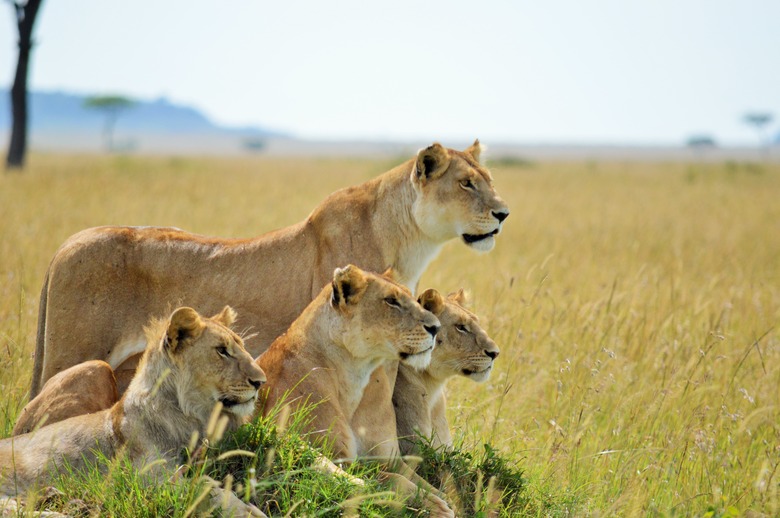Difference Between Male & Female Lions
Lions represent the pinnacle of the cat world. While these magnificent and revered creatures once roamed throughout the world, they are now found only in parts of sub-Saharan Africa, plus a small population of Asian lions in the Gir Forest of India. Male and female lions have a number of differences between them, including their physical characteristics, their role within the social structure and the path their lives take.
Differences in Physical Characteristics
Differences in Physical Characteristics
Male lions possess an iconic mane that encircles their head; females do not. The color of the manes indicates both age and prowess. Fully mature males weigh between 330 and 550 lbs.; females weigh between 265 and 395 lbs. Males can reach lengths of 10 feet (including tail), and females are generally less than 9 feet long. Both sexes stand about 4 feet high. In the wild, males typically live 12 years; females average a lifespan of 15 years.
Gender Makeup of a Pride
Gender Makeup of a Pride
Lions, as the only social cats, live in groups called prides. Prides consist of between three and 40 lions, with 15 being the average. Females commonly remain with their birth pride for life, but males leave after two to four years. There are generally only one or two adult male lions in each pride.
Differences in Pride Responsibilities
Differences in Pride Responsibilities
Males are primarily responsible for the security of their pride. While they will participate in hunting, they spend the majority of their time on security patrols. They will defend their pride's territory, which can cover up to 100 square miles. Females are primarily responsible for hunting, which typically occurs after dark. They are also the primary caregivers for lion cubs. The eating hierarchy is males first, followed by females and then cubs.
Child Rearing
Child Rearing
Female lions have litters of one to six cubs, with the average being two to four. These cubs typically weigh 2 to 4 lbs. at birth. The females of a pride all give birth at the same time and then co-raise the pride's cubs, including suckling one another's cubs. The cubs reach independence at around two years of age. The male's role in child rearing is primarily protection. However, because of the scarcity of food and attacks by other males, around 60 to 70 percent of all cubs die within these two years.
Difference in the Lives of Males
Difference in the Lives of Males
Unlike females, male lions leave their birth prides at between two to four years of age. They initially form groups or coalitions with other young males from their pride. During this period, the males roam and progress toward full maturity. Upon reaching maturity, they seek to establish their own prides by taking over other prides. If they are successful in ousting a pride's males, they quickly kill all the pride's cubs. This is done so that they can then mate and sire their own cubs. The killing is necessary because females will not mate again until their cubs reach around two years of age, and the male lion will usually remain with the pride for only two to three years before being run off himself by new male challengers.
Cite This Article
MLA
Bennett, Doug. "Difference Between Male & Female Lions" sciencing.com, https://www.sciencing.com/difference-between-male-female-lions-8639894/. 5 April 2018.
APA
Bennett, Doug. (2018, April 5). Difference Between Male & Female Lions. sciencing.com. Retrieved from https://www.sciencing.com/difference-between-male-female-lions-8639894/
Chicago
Bennett, Doug. Difference Between Male & Female Lions last modified March 24, 2022. https://www.sciencing.com/difference-between-male-female-lions-8639894/
